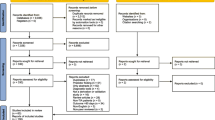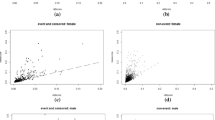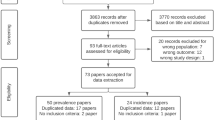Abstract
Aims
The methodological quality of development, validation, and modification of those models have not been evaluated via a thoroughly literature review. This study aims to describe the overall status and evaluate the methodological quality of risk prediction models for stroke incidence in the general population.
Methods
We searched the database of EMBASE and MEDLINE by the combination of subject words and key words to collect the research on stroke risk prediction model in the general population. The retrieval time was from the establishment of the database to September 2019. It should be mentioned that risk of bias for each model was assessed, and data on population characteristics and model performance was also extracted.
Results
The search screened 11,386 peer-reviewed publications and 57 citation searching, of which 48 were included in the review, describing the development of 51 prediction models, 47 external validation models, and 12 modification models. Among 51 development models, the predicted outcome concentrated on fatal or non-fatal stroke (n = 37, 73%). Thirty-nine development models (76%) were without internal validation. C-statistic or AUC was adopted for discrimination in 80% models, and Hosmer-Lemeshow test (n = 25, 49%) was also performed for calibration. Twenty-six development models (53%) were externally validated, among which only 2 (8%) were validated by independent researchers. Risk prediction performance was improved when models were modified by adding novel risk factors, such as the internal carotid artery plaque and intima-media thickness.
Conclusion
Models for predicting stroke occurrence need further external validation, recalibration, or modification in different populations, to help interpret those models in the practice of stroke prevention.



Similar content being viewed by others
References
Katan M, Luft A (2018) Global burden of stroke. Semin Neurol 38:208–211. https://doi.org/10.1055/s-0038-1649503
Feigin VL, Norrving B, Mensah GA (2017) Global burden of stroke. Circ Res 120:439–448. https://doi.org/10.1161/circresaha.116.308413
Group GNDC (2017) Global, regional, and national burden of neurological disorders during 1990-2015: a systematic analysis for the Global Burden of Disease Study 2015. The Lancet Neurology 16:877–897. https://doi.org/10.1016/s1474-4422(17)30299-5
Feigin VL, Forouzanfar MH, Krishnamurthi R et al (2014) Global and regional burden of stroke during 1990-2010: findings from the Global Burden of Disease Study 2010. Lancet 383:245–255
Saver JL, Carroll JD, Smalling R et al (2015) Letter by Saver et al regarding article, “Guidelines for the prevention of stroke in patients with stroke and transient ischemic attack: a guideline for healthcare professionals from the American Heart Association/American Stroke Association”. Stroke 46:e85–e86. https://doi.org/10.1161/strokeaha.115.007311
Go AS, Mozaffarian D, Roger VL et al (2014) Heart disease and stroke statistics--2014 update: a report from the American Heart Association. Circulation 129:e28–e292. 2013/12/20. https://doi.org/10.1161/01.cir.0000441139.02102.80
Steiger N, Cifu AS (2016) Primary prevention of stroke. JAMA 316:658–659. https://doi.org/10.1001/jama.2016.5529
Williams TGS, Cubiella J, Griffin SJ et al (2016) Risk prediction models for colorectal cancer in people with symptoms: a systematic review. BMC Gastroenterol 16:1–16
Chien KL, Hsu HC, Su TC et al (2012) Constructing a point-based prediction model for the risk of coronary artery disease in a Chinese community: a report from a cohort study in Taiwan. Int J Cardiol 157:263–268. https://doi.org/10.1016/j.ijcard.2012.03.017
Chambless LE, Heiss G, Shahar E et al (2004) Prediction of ischemic stroke risk in the Atherosclerosis Risk in Communities Study. Am J Epidemiol 160:259–269. https://doi.org/10.1093/aje/kwh189
Ekundayo OJ, Vassar SD, Williams LS et al (2011) Using administrative databases to calculate Framingham scores within a large health care organization. Stroke 42:1982–1987. Article. https://doi.org/10.1161/STROKEAHA.110.603340
Borglykke A, Andreasen AH, Kuulasmaa K et al (2010) Stroke risk estimation across nine European countries in the MORGAM project. Heart 96:1997–2004. https://doi.org/10.1136/hrt.2010.207555
Piepoli MF, Hoes AW, Agewall S et al (2016) 2016 European guidelines on cardiovascular disease prevention in clinical practice: the Sixth Joint Task Force of the European Society of Cardiology and Other Societies on Cardiovascular Disease Prevention in Clinical Practice (constituted by representatives of 10 societies and by invited experts) developed with the special contribution of the European Association for Cardiovascular Prevention & Rehabilitation (EACPR). Eur Heart J 37:2315–2381. https://doi.org/10.1093/eurheartj/ehw106
Marrugat J, Subirana I, Ramos R et al (2014) Derivation and validation of a set of 10-year cardiovascular risk predictive functions in Spain: the FRESCO Study. Prev Med 61:66–74. Article. https://doi.org/10.1016/j.ypmed.2013.12.031
Ishikawa S, Matsumoto M, Kayaba K, Gotoh T, Nago N, Tsutsumi A, Kajii E, Jichi Medical School (JMS) Cohort Study Group (2009) Risk charts illustrating the 10-year risk of stroke among residents of Japanese rural communities: the JMS Cohort Study. J Epidemiol 19:101–106
D’Agostino RB Sr, Vasan RS, Pencina MJ et al (2008) General cardiovascular risk profile for use in primary care: the Framingham Heart Study. Circulation 117:743–753. Article. https://doi.org/10.1161/CIRCULATIONAHA.107.699579
Yu T, Vollenweider D, Varadhan R, Li T, Boyd C, Puhan MA (2013) Support of personalized medicine through risk-stratified treatment recommendations - an environmental scan of clinical practice guidelines. BMC Med 11:7. https://doi.org/10.1186/1741-7015-11-7
Kim AS, Johnston SC (2011) Global variation in the relative burden of stroke and ischemic heart disease. Circulation 124:314–323. https://doi.org/10.1161/circulationaha.111.018820
Johnston SC, Mendis S, Mathers CD (2009) Global variation in stroke burden and mortality: estimates from monitoring, surveillance, and modelling. Lancet Neurol 8:345–354. https://doi.org/10.1016/s1474-4422(09)70023-7
Fuster V, Voute J, Hunn M et al (2007) Low priority of cardiovascular and chronic diseases on the global health agenda: a cause for concern. Circulation 116:1966–1970. https://doi.org/10.1161/circulationaha.107.733444
Wolf PA, D’Agostino RB, Belanger AJ et al (1991) Probability of stroke: a risk profile from the Framingham Study. Stroke 22:312–318. https://doi.org/10.1161/01.str.22.3.312
Meschia JF, Bushnell C, Boden-Albala B et al (2014) Guidelines for the primary prevention of stroke: a statement for healthcare professionals from the American Heart Association/American Stroke Association. Stroke 45:3754–3832. https://doi.org/10.1161/str.0000000000000046
Neurology CSo and Society CS (2019) Guidelines for the primary prevention of cerebrovascular diseases in China. Chinese Journal of Neurology 9:684–709
D’Agostino RB, Wolf PA, Belanger AJ et al (1994) Stroke risk profile: adjustment for antihypertensive medication: The Framingham Study. Stroke 25:40–43 Article
Parmar P, Krishnamurthi R, Ikram MA, Hofman A, Mirza SS, Varakin Y, Kravchenko M, Piradov M, Thrift AG, Norrving B, Wang W, Mandal DK, Barker-Collo S, Sahathevan R, Davis S, Saposnik G, Kivipelto M, Sindi S, Bornstein NM, Giroud M, Béjot Y, Brainin M, Poulton R, Narayan KM, Correia M, Freire A, Kokubo Y, Wiebers D, Mensah G, BinDhim N, Barber PA, Pandian JD, Hankey GJ, Mehndiratta MM, Azhagammal S, Ibrahim NM, Abbott M, Rush E, Hume P, Hussein T, Bhattacharjee R, Purohit M, Feigin VL, Stroke RiskometerTM Collaboration Writing Group (2015) The Stroke Riskometer (TM) App: validation of a data collection tool and stroke risk predictor. Int J Stroke 10:231–244. https://doi.org/10.1111/ijs.12411
Yang X, Li J, Hu D et al (2016) Predicting the 10-year risks of atherosclerotic cardiovascular disease in Chinese population: the China-PAR Project (prediction for ASCVD risk in China). Circulation 134:1430–1440. https://doi.org/10.1161/circulationaha.116.022367
Damen JA, Hooft L, Schuit E, Debray TP, Collins GS, Tzoulaki I, Lassale CM, Siontis GC, Chiocchia V, Roberts C, Schlüssel MM, Gerry S, Black JA, Heus P, van der Schouw Y, Peelen LM, Moons KG (2016) Prediction models for cardiovascular disease risk in the general population: systematic review. BMJ 353:i2416. https://doi.org/10.1136/bmj.i2416
Moons KGM, de Groot JAH, Bouwmeester W et al (2014) Critical appraisal and data extraction for systematic reviews of prediction modelling studies: the CHARMS checklist. PLoS Med 11:e1001744. https://doi.org/10.1371/journal.pmed.1001744
Debray TP, Damen JA, Snell KI et al (2017) A guide to systematic review and meta-analysis of prediction model performance. BMJ 356:i6460. https://doi.org/10.1136/bmj.i6460
Steyerberg EW, Pencina MJ, Lingsma HF et al (2012) Assessing the incremental value of diagnostic and prognostic markers: a review and illustration. Eur J Clin Investig 42:216–228. 2011/07/06. https://doi.org/10.1111/j.1365-2362.2011.02562.x
Damen JA, Pajouheshnia R, Heus P et al (2019) Performance of the Framingham risk models and pooled cohort equations for predicting 10-year risk of cardiovascular disease: a systematic review and meta-analysis. BMC Med 17:109. https://doi.org/10.1186/s12916-019-1340-7
Wolff RF, Moons KGM, Riley RD, Whiting PF, Westwood M, Collins GS, Reitsma JB, Kleijnen J, Mallett S, PROBAST Group† (2019) PROBAST: a tool to assess the risk of bias and applicability of prediction model studies. Ann Intern Med 170:51–58. https://doi.org/10.7326/M18-1376
Moons KGM, Wolff RF, Riley RD, Whiting PF, Westwood M, Collins GS, Reitsma JB, Kleijnen J, Mallett S (2019) PROBAST: a tool to assess risk of bias and applicability of prediction model studies: explanation and elaboration. Ann Intern Med 170:W1–W33. https://doi.org/10.7326/M18-1377
Bots ML, Hoes AW, Hofman A et al (1999) Cross-sectionally assessed carotid intima-media thickness relates to long-term risk of stroke, coronary heart disease and death as estimated by available risk functions. J Intern Med 245:269–276. https://doi.org/10.1046/j.1365-2796.1999.0442f.x
Chien KL, Su TC, Hsu HC, Chang WT, Chen PC, Sung FC, Chen MF, Lee YT (2010) Constructing the prediction model for the risk of stroke in a Chinese population: report from a cohort study in Taiwan. Stroke 41:1858–1864. https://doi.org/10.1161/STROKEAHA.110.586222
Truelsen T, Lindenstrøm E, Boysen G (1994) Comparison of probability of stroke between the Copenhagen City Heart Study and the Framingham Study. Stroke 25:802–807 Article
Voko Z, Hollander M, Koudstaal PJ et al (2004) How do American stroke risk functions perform in a Western European population? Neuroepidemiology 23:247–253
Lumley T, Kronmal RA, Cushman M et al (2002) A stroke prediction score in the elderly: validation and Web-based application. J Clin Epidemiol 55:129–136. https://doi.org/10.1016/s0895-4356(01)00434-6
Howard G, McClure LA, Moy CS et al (2017) Self-reported stroke risk stratification. Stroke 48:1737–1743. Article. https://doi.org/10.1161/STROKEAHA.117.016757
Zhou XH, Wang X, Duncan A et al (2017) Statistical evaluation of adding multiple risk factors improves Framingham stroke risk score. BMC Med Res Methodol 17:58. Article. https://doi.org/10.1186/s12874-017-0330-8
Bos D, Ikram MA, Leening MJG et al (2017) The revised Framingham stroke risk profile in a primary prevention population. Circulation 135:2207–2209. Article. https://doi.org/10.1161/CIRCULATIONAHA.117.028429
Dufouil C, Beiser A, McLure LA et al (2017) Revised Framingham stroke risk profile to reflect temporal trends. Circulation 135:1145–1159. https://doi.org/10.1161/circulationaha.115.021275
Hippisley-Cox J, Coupland C, Brindle P (2013) Derivation and validation of QStroke score for predicting risk of ischaemic stroke in primary care and comparison with other risk scores: a prospective open cohort study. BMJ 346:f2573. https://doi.org/10.1136/bmj.f2573
McClure LA, Kleindorfer DO, Kissela BM et al (2014) Assessing the performance of the framingham stroke risk score in the reasons for geographic and racial differences in stroke cohort. Stroke 45:1716–1720. Article. https://doi.org/10.1161/STROKEAHA.114.004915
Bineau S, Dufouil C, Helmer C, Ritchie K, Empana JP, Ducimetière P, Alpérovitch A, Bousser MG, Tzourio C (2009) Framingham stroke risk function in a large population-based cohort of elderly people: the 3C study. Stroke 40:1564–1570. https://doi.org/10.1161/STROKEAHA.108.532325
Xing X, Yang X, Liu F et al (2019) Predicting 10-year and lifetime stroke risk in Chinese population. Stroke 50:2371–2378. https://doi.org/10.1161/strokeaha.119.025553
Anderson KM, Odell PM, Wilson PW et al (1991) Cardiovascular disease risk profiles. Am Heart J 121:293–298. https://doi.org/10.1016/0002-8703(91)90861-b
Lee JW, Lim HS, Kim DW et al (2018) The development and implementation of stroke risk prediction model in National Health Insurance Service’s personal health record. Comput Methods Prog Biomed 153:253–257. Article. https://doi.org/10.1016/j.cmpb.2017.10.007
Manuel DG, Tuna M, Perez R, et al (2015) Predicting stroke risk based on health behaviours: Development of the Stroke Population Risk Tool (SPoRT). PLoS ONE 10:e0143342. https://doi.org/10.1371/journal.pone.0143342
Selmer R, Igland J, Ariansen I, Tverdal A, Njølstad I, Furu K, Tell GS, Klemsdal TO (2017) NORRISK 2: A Norwegian risk model for acute cerebral stroke and myocardial infarction. Eur J Prev Cardiol 24:773–782. https://doi.org/10.1177/2047487317693949
Wu Y, Liu X, Li X, Li Y, Zhao L, Chen Z, Li Y, Rao X, Zhou B, Detrano R, Liu K (2006) USA-PRC Collaborative Study of Cardiovascular and Cardiopulmonary Epidemiology Research Group., China Multicenter Collaborative Study of Cardiovascular Epidemiology Research Group. Estimation of 10-year risk of fatal and nonfatal ischemic cardiovascular diseases in Chinese adults. Circulation 114:2217–2225
Assmann G, Schulte H, Cullen P, Seedorf U (2007) Assessing risk of myocardial infarction and stroke: new data from the Prospective Cardiovascular Munster (PROCAM) study. Eur J Clin Investig 37:925–932
Yatsuya H, Iso H, Yamagishi K, Kokubo Y, Saito I, Suzuki K, Sawada N, Inoue M, Tsugane S (2013) Development of a point-based prediction model for the incidence of total stroke: Japan public health center study. Stroke 44:1295–1302. https://doi.org/10.1161/STROKEAHA.111.677534
Yatsuya H, Iso H, Li Y, Yamagishi K, Kokubo Y, Saito I, Sawada N, Inoue M, Tsugane S (2016) Development of a risk equation for the incidence of coronary artery disease and ischemic stroke for middle-aged Japanese - Japan Public Health Center-Based Prospective Study. Circ J 80:1386–1395. https://doi.org/10.1253/circj.CJ-16-0081
Prati P, Tosetto A, Casaroli M et al (2011) Carotid plaque morphology improves stroke risk prediction: usefulness of a new ultrasonographic score. Cerebrovasc Dis 31:300–304. Article. https://doi.org/10.1159/000320852
Ziegelbauer K, Schaefer C, Steinmetz H et al (2013) Clinical usefulness of carotid ultrasound to improve stroke risk assessment: ten-year results from the Carotid Atherosclerosis Progression Study (CAPS). Eur J Prev Cardiol 20:837–843. Article. https://doi.org/10.1177/2047487312449589
Gardin JM, Bartz TM, Polak JF et al (2014) What do carotid Intima-media thickness and plaque add to the prediction of stroke and cardiovascular disease risk in older adults? the cardiovascular health study. J Am Soc Echocardiogr 27:998–1005. Article. https://doi.org/10.1016/j.echo.2014.06.013
Polak JF, Szklo M, Kronmal RA et al (2013) The value of carotid artery plaque and intima-media thickness for incident cardiovascular disease: the multi-ethnic study of atherosclerosis. J Am Heart Assoc 2:e000087. https://doi.org/10.1161/jaha.113.000087
Ibrahim-Verbaas CA, Fornage M, Bis JC et al (2014) Predicting stroke through genetic risk functions the CHARGE risk score project. Stroke 45:403–412. Article. https://doi.org/10.1161/STROKEAHA.113.003044
Evans TE, O’Sullivan MJ, De Groot M et al (2016) White matter microstructure improves stroke risk prediction in the general population. Stroke 47:2756–2762. Article. https://doi.org/10.1161/STROKEAHA.116.014651
Poels MMF, Steyerberg EW, Wieberdink RG et al (2012) Assessment of cerebral small vessel disease predicts individual stroke risk. J Neurol Neurosurg Psychiatry 83:1174–1179. https://doi.org/10.1136/jnnp-2012-302381
Neumann JT, Havulinna AS, Zeller T et al (2014) Comparison of three troponins as predictors of future cardiovascular events--prospective results from the FINRISK and BiomaCaRE studies. PLoS One 9:e90063. https://doi.org/10.1371/journal.pone.0090063
Liu J, Hong Y, D’Agostino RB, Sr. et al (2004) Predictive value for the Chinese population of the Framingham CHD risk assessment tool compared with the Chinese Multi-Provincial Cohort Study. Jama 291:2591–2599. https://doi.org/10.1001/jama.291.21.2591
Brindle P, Beswick A, Fahey T, Ebrahim S (2006) Accuracy and impact of risk assessment in the primary prevention of cardiovascular disease: a systematic review. Heart 92:1752–1759. https://doi.org/10.1136/hrt.2006.087932
Menotti A, Lanti M, Agabiti-Rosei E et al (2005) Riskard 2005. New tools for prediction of cardiovascular disease risk derived from Italian population studies. Nutr Metab Cardiovasc Dis 15:426–440. https://doi.org/10.1016/j.numecd.2005.07.007
Zhou M, Wang H, Zhu J et al (2016) Cause-specific mortality for 240 causes in China during 1990-2013: a systematic subnational analysis for the Global Burden of Disease Study 2013. Lancet 387:251–272. 2015/10/30. https://doi.org/10.1016/s0140-6736(15)00551-6
Aslibekyan S, Campos H, Loucks EB et al (2011) Development of a cardiovascular risk score for use in low- and middle-income countries. J Nutr 141:1375–1380. https://doi.org/10.3945/jn.110.133140
Ito H, Pacold IV, Durazo-Arvizu R et al (2011) The effect of including cystatin C or creatinine in a cardiovascular risk model for asymptomatic individuals: the multi-ethnic study of atherosclerosis. Am J Epidemiol 174:949–957. https://doi.org/10.1093/aje/kwr185
Tanabe N, Iso H, Okada K et al (2010) Serum total and non-high-density lipoprotein cholesterol and the risk prediction of cardiovascular events - the JALS-ECC. Circ J 74:1346–1356. https://doi.org/10.1253/circj.cj-09-0861
Tanne D, Yaari S, Goldbourt U (1998) Risk profile and prediction of long-term ischemic stroke mortality: a 21-year follow-up in the Israeli Ischemic Heart Disease (IIHD) Project. Circulation 98:1365–1371. https://doi.org/10.1161/01.cir.98.14.1365
Moons KG, Kengne AP, Woodward M et al (2012) Risk prediction models: I. Development, internal validation, and assessing the incremental value of a new (bio)marker. Heart 98:683–690. https://doi.org/10.1136/heartjnl-2011-301246
Labarere J, Renaud B, Fine MJ (2014) How to derive and validate clinical prediction models for use in intensive care medicine. Intensive Care Med 40:513–527. https://doi.org/10.1007/s00134-014-3227-6
Granholm A, Perner A, Jensen AKG, et al (2019) Important methodological flaws in the recently published clinical prediction model the REMEMBER score. Critical care (London, England) 23:71. https://doi.org/10.1186/s13054-019-2363-3
Berger JS, Jordan CO, Lloyd-Jones D et al (2010) Screening for cardiovascular risk in asymptomatic patients. J Am Coll Cardiol 55:1169–1177. https://doi.org/10.1016/j.jacc.2009.09.066
Bitton A, Gaziano TA (2010) The Framingham Heart Study’s impact on global risk assessment. Prog Cardiovasc Dis 53:68–78. https://doi.org/10.1016/j.pcad.2010.04.001
Qiao Q, Gao W, Laatikainen T et al (2012) Layperson-oriented vs. clinical-based models for prediction of incidence of ischemic stroke: National FINRISK Study. Int J Stroke 7:662–668. Article. https://doi.org/10.1111/j.1747-4949.2011.00692.x
Zhang X, Patel A, Horibe H, Wu Z, Barzi F, Rodgers A, MacMahon S, Woodward M, Asia Pacific Cohort Studies Collaboration (2003) Cholesterol, coronary heart disease, and stroke in the Asia Pacific region. Int J Epidemiol 32:563–572
Zhang XF, Attia J, D’Este C et al (2005) A risk score predicted coronary heart disease and stroke in a Chinese cohort. J Clin Epidemiol 58:951–958. https://doi.org/10.1016/j.jclinepi.2005.01.013
Collins GS, Moons KG (2012) Comparing risk prediction models. BMJ 344:e3186. https://doi.org/10.1136/bmj.e3186
Hlatky MA, Greenland P, Arnett DK et al (2009) Criteria for evaluation of novel markers of cardiovascular risk: a scientific statement from the American Heart Association. Circulation 119:2408–2416. https://doi.org/10.1161/circulationaha.109.192278
Payne BA, Hutcheon JA, Dunsmuir D et al (2015) Assessing the incremental value of blood oxygen saturation (SpO(2)) in the miniPIERS (Pre-eclampsia Integrated Estimate of RiSk) risk prediction model. J Obstet Gynaecol Can 37:16–24. https://doi.org/10.1016/s1701-2163(15)30358-3
Acknowledgements
We would like to thank Huang Jiuyi for providing stroke clinical expertise in the critical appraisal of the included studies.
Funding
This research was supported by the National Natural Science Foundation of China (Grant No. 8187111615)
Author information
Authors and Affiliations
Corresponding author
Ethics declarations
Ethical approval
“None” (Mandatory)
Conflict of interest
The authors declare no competing interests.
Additional information
Publisher’s note
Springer Nature remains neutral with regard to jurisdictional claims in published maps and institutional affiliations.
Supplementary Information
ESM 1
(DOCX 152 kb)
Rights and permissions
About this article
Cite this article
Xu, W., Huang, J., Yu, Q. et al. A systematic review of the status and methodological considerations for estimating risk of first ever stroke in the general population. Neurol Sci 42, 2235–2247 (2021). https://doi.org/10.1007/s10072-021-05219-w
Received:
Accepted:
Published:
Issue Date:
DOI: https://doi.org/10.1007/s10072-021-05219-w




